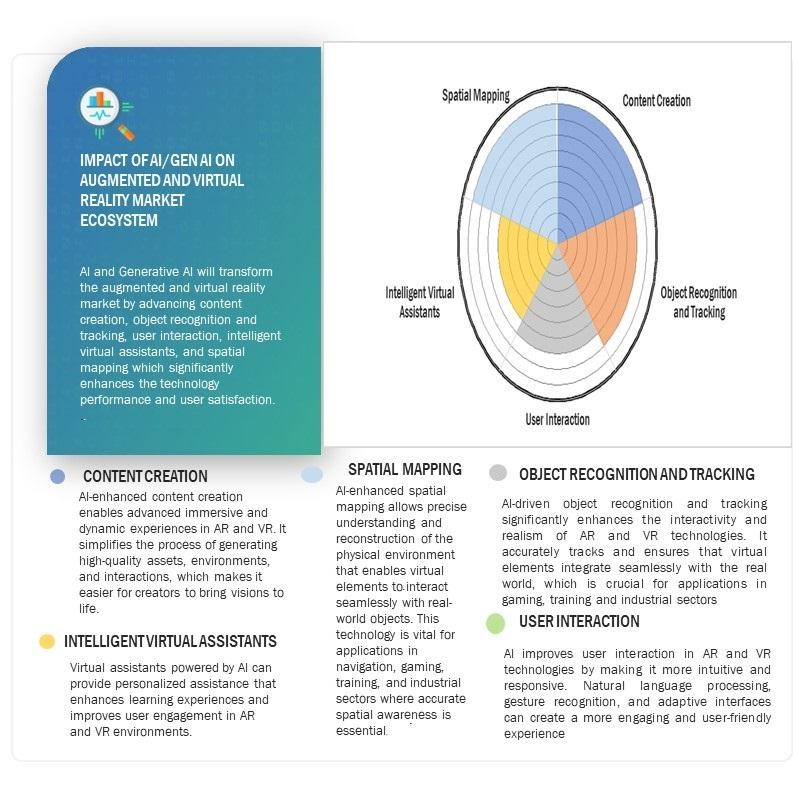The Augmented Reality and Virtual Reality Market was valued at USD 22.12 billion in 2024 and is expected to reach USD $96.32 billion by 2029, at a CAGR of 34.2% during the 2024-2029 period.
Rapid growth of AR and VR applications in the gaming and entertainment industry are the major drivers of the augmented and virtual reality market. This is attributed to AR delivering uncommon combination that refashions how people relate with the digital content and VR enhancing the performance, compactness, and comfort such as Apple Vision Pro, Meta Quest 3. Furthermore, the growing implementation of government initiatives and investments towards AR and VR technologies provides growth opportunities in the augmented and virtual reality market. For instance, In September 2023, a UK-based holographic company Envisics, that manufactures in-car technology that projects navigation and safety alerts on the windscreen rose to USD 100 million in its Series C round is expected to help AR head-up displays reach commercialization over the forecast period.
Download PDF Copy:
https://www.marketsandmarkets.com/pdfdownloadNew.asp?id=1185
Impact of AI/Gen AI on augmented and virtual reality market
The major use cases of AI/Gen AI in the augmented and virtual reality market includes content creation, object recognition and tracking, user interaction, intelligent virtual assistants and spatial mapping. AI-enhanced content creation empowers the fast and easy generation of quality assets, environments, and interactions that provide more immersive and dynamic AR and VR experiences. AI-driven object recognition and tracking boost interactivity and realism several-fold by ensuring that virtual elements fit well into the real world—key to gaming, training, and industrial applications. Besides, AI enhances user interaction with intuitive and responsive interaction through natural language processing, gesture recognition, and adaptive interfaces that give better user engagement. Other benefits are AI-powered virtual assistants that can provide personalized aid and learn; however, their full potential is again limited because of technological and integrational challenges. Finally, spatial mapping enhanced by AI is required in the development of most immersive AR and VR experiences, since it accurately perceives and reconstructs physical environments; in this regard, spatial awareness drives applications like navigation, gaming, and training.
The major players in the augmented and virtual reality companies include Meta. (US), Sony Group Corporation (Japan), Apple, Inc. (US), ByteDance (China), and DPVR (China).
AR head-mounted displays (HMDs) and VR gesture tracking devices are expected to witness the highest CAGR in the augmented and virtual reality market during the forecast period
AR head-mounted displays (HMDs) are expected to witness the highest CAGR in the augmented reality market during the forecast period. This is attributed to the accelerating adoption of AR HMDs in consumer, and aerospace and defense applications. In consumer applications AR HMDs are highly used in gaming, sports, and entertainment sector. They help rogue pilots in the air force and navy personnel to clearly view and aim at enemy operations more accurately. The other segment involved in this category is the AR smart eyewear segment. It is gaining the interest of enterprises and healthcare, retail, automotive and consumer segments. Major industry players, which include Osterhout Design Group (UK), Epson, Google, Magic Leap, Vuzix, and Solos (UK) are committed to the hype of augmented reality smart whereas in the case of the virtual reality hardware consumer ones, the crucial hardware device in the virtual reality domain is the VR gesture tracking device. The VR gesture tracking device will render the user immersed. So naturally, the demand for the gesture tracking devices will soar in the virtual reality industry.
Asia Pacific region is expected to witness the highest CAGR in the augmented and virtual reality market during forecast period
Asia Pacific is expected to witness the highest CAGR in the augmented and virtual reality market during the forecast period, primarily due to the factors such as widespread use of smartphones, increased adoption of smart electronic devices, rising demand for AR technology in healthcare applications, presence of numerous key players in the region such as Sony Group Corporation, ByteDance, DPVR among others, and availability of cost-effective VR products from local manufacturers, especially in China. Therefore, Asia Pacific is expected to witness the highest CAGR during the forecast period.



